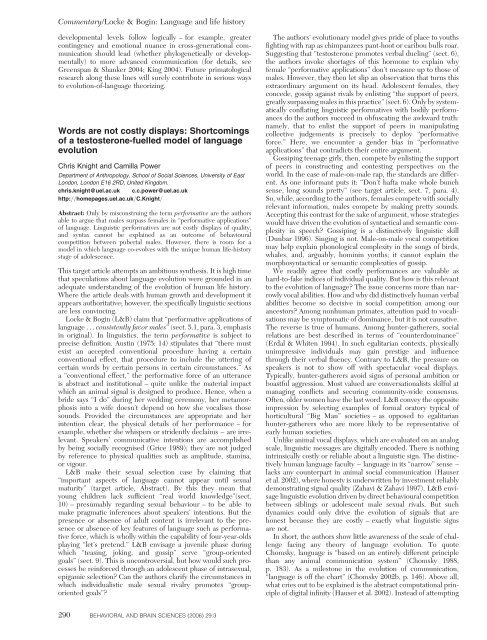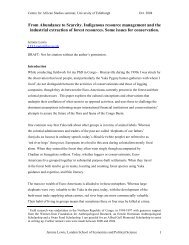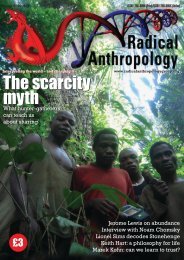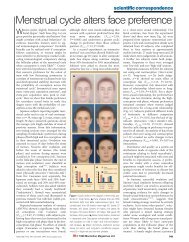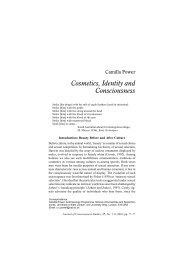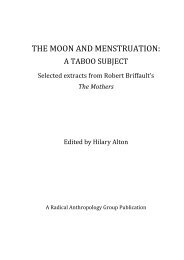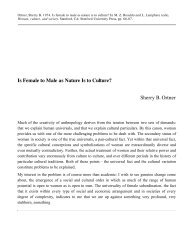Commentary/Locke & Bogin: <str<strong>on</strong>g>Language</str<strong>on</strong>g> <str<strong>on</strong>g>and</str<strong>on</strong>g> <str<strong>on</strong>g>life</str<strong>on</strong>g> <str<strong>on</strong>g>history</str<strong>on</strong>g><strong>development</strong>al levels follow logically – for example, greaterc<strong>on</strong>tingency <str<strong>on</strong>g>and</str<strong>on</strong>g> emoti<strong>on</strong>al nuance in cross-generati<strong>on</strong>al communicati<strong>on</strong>should lead (whe<strong>the</strong>r phylogenetically or <strong>development</strong>ally)to more advanced communicati<strong>on</strong> (for details, seeGreenspan & Shanker 2004; King 2004). Future primatologicalresearch al<strong>on</strong>g <strong>the</strong>se lines will surely c<strong>on</strong>tribute in serious waysto evoluti<strong>on</strong>-of-language <strong>the</strong>orizing.Words are not costly displays: Shortcomingsof a testoster<strong>on</strong>e-fuelled model of languageevoluti<strong>on</strong>Chris Knight <str<strong>on</strong>g>and</str<strong>on</strong>g> Camilla PowerDepartment of Anthropology, School of Social Sciences, University of EastL<strong>on</strong>d<strong>on</strong>, L<strong>on</strong>d<strong>on</strong> E16 2RD, United Kingdom.chris.knight@uel.ac.uk c.c.power@uel.ac.ukhttp://homepages.uel.ac.uk/C.Knight/Abstract: Only by misc<strong>on</strong>struing <strong>the</strong> term performative are <strong>the</strong> authorsable to argue that males surpass females in “performative applicati<strong>on</strong>s”of language. Linguistic performatives are not costly displays of quality,<str<strong>on</strong>g>and</str<strong>on</strong>g> syntax cannot be explained as an outcome of behaviouralcompetiti<strong>on</strong> between pubertal males. However, <strong>the</strong>re is room for amodel in which language co-evolves with <strong>the</strong> unique human <str<strong>on</strong>g>life</str<strong>on</strong>g>-<str<strong>on</strong>g>history</str<strong>on</strong>g>stage of adolescence.This target article attempts an ambitious syn<strong>the</strong>sis. It is high timethat speculati<strong>on</strong>s about language evoluti<strong>on</strong> were grounded in anadequate underst<str<strong>on</strong>g>and</str<strong>on</strong>g>ing of <strong>the</strong> evoluti<strong>on</strong> of human <str<strong>on</strong>g>life</str<strong>on</strong>g> <str<strong>on</strong>g>history</str<strong>on</strong>g>.Where <strong>the</strong> article deals with human growth <str<strong>on</strong>g>and</str<strong>on</strong>g> <strong>development</strong> itappears authoritative; however, <strong>the</strong> specifically linguistic secti<strong>on</strong>sare less c<strong>on</strong>vincing.Locke & Bogin (L&B) claim that “performative applicati<strong>on</strong>s oflanguage ...c<strong>on</strong>sistently favor males” (sect. 5.1, para. 3, emphasisin original). In linguistics, <strong>the</strong> term performative is subject toprecise definiti<strong>on</strong>. Austin (1975: 14) stipulates that “<strong>the</strong>re mustexist an accepted c<strong>on</strong>venti<strong>on</strong>al procedure having a certainc<strong>on</strong>venti<strong>on</strong>al effect, that procedure to include <strong>the</strong> uttering ofcertain words by certain pers<strong>on</strong>s in certain circumstances.” Asa “c<strong>on</strong>venti<strong>on</strong>al effect,” <strong>the</strong> performative force of an utteranceis abstract <str<strong>on</strong>g>and</str<strong>on</strong>g> instituti<strong>on</strong>al – quite unlike <strong>the</strong> material impactwhich an animal signal is designed to produce. Hence, when abride says “I do” during her wedding cerem<strong>on</strong>y, her metamorphosisinto a wife doesn’t depend <strong>on</strong> how she vocalises thosesounds. Provided <strong>the</strong> circumstances are appropriate <str<strong>on</strong>g>and</str<strong>on</strong>g> herintenti<strong>on</strong> clear, <strong>the</strong> physical details of her performance – forexample, whe<strong>the</strong>r she whispers or stridently declaims – are irrelevant.Speakers’ communicative intenti<strong>on</strong>s are accomplishedby being socially recognised (Grice 1989); <strong>the</strong>y are not judgedby reference to physical qualities such as amplitude, stamina,or vigour.L&B make <strong>the</strong>ir sexual selecti<strong>on</strong> case by claiming that“important aspects of language cannot appear until sexualmaturity” (target article, Abstract). By this <strong>the</strong>y mean thatyoung children lack sufficient “real world knowledge”(sect.10) – presumably regarding sexual behaviour – to be able tomake pragmatic inferences about speakers’ intenti<strong>on</strong>s. But <strong>the</strong>presence or absence of adult c<strong>on</strong>tent is irrelevant to <strong>the</strong> presenceor absence of key features of language such as performativeforce, which is wholly within <strong>the</strong> capability of four-year-oldsplaying “let’s pretend.” L&B envisage a juvenile phase duringwhich “teasing, joking, <str<strong>on</strong>g>and</str<strong>on</strong>g> gossip” serve “group-orientedgoals” (sect. 9). This is unc<strong>on</strong>troversial, but how would such processesbe reinforced through an adolescent phase of intrasexual,epigamic selecti<strong>on</strong>? Can <strong>the</strong> authors clarify <strong>the</strong> circumstances inwhich individualistic male sexual rivalry promotes “grouporientedgoals”?The authors’ evoluti<strong>on</strong>ary model gives pride of place to youthsfighting with rap as chimpanzees pant-hoot or caribou bulls roar.Suggesting that “testoster<strong>on</strong>e promotes verbal dueling” (sect. 6),<strong>the</strong> authors invoke shortages of this horm<strong>on</strong>e to explain whyfemale “performative applicati<strong>on</strong>s” d<strong>on</strong>’t measure up to those ofmales. However, <strong>the</strong>y <strong>the</strong>n let slip an observati<strong>on</strong> that turns thisextraordinary argument <strong>on</strong> its head. Adolescent females, <strong>the</strong>yc<strong>on</strong>cede, gossip against rivals by enlisting “<strong>the</strong> support of peers,greatly surpassing males in this practice” (sect. 6). Only by systematicallyc<strong>on</strong>flating linguistic performatives with bodily performancesdo <strong>the</strong> authors succeed in obfuscating <strong>the</strong> awkward truth:namely, that to enlist <strong>the</strong> support of peers in manipulatingcollective judgements is precisely to deploy “performativeforce.” Here, we encounter a gender bias in “performativeapplicati<strong>on</strong>s” that c<strong>on</strong>tradicts <strong>the</strong>ir entire argument.Gossiping teenage girls, <strong>the</strong>n, compete by enlisting <strong>the</strong> supportof peers in c<strong>on</strong>structing <str<strong>on</strong>g>and</str<strong>on</strong>g> c<strong>on</strong>testing <str<strong>on</strong>g>perspective</str<strong>on</strong>g>s <strong>on</strong> <strong>the</strong>world. In <strong>the</strong> case of male-<strong>on</strong>-male rap, <strong>the</strong> st<str<strong>on</strong>g>and</str<strong>on</strong>g>ards are different.As <strong>on</strong>e informant puts it: “D<strong>on</strong>’t hafta make whole bunchsense, l<strong>on</strong>g sounds pretty” (see target article, sect. 7, para. 4).So, while, according to <strong>the</strong> authors, females compete with sociallyrelevant informati<strong>on</strong>, males compete by making pretty sounds.Accepting this c<strong>on</strong>trast for <strong>the</strong> sake of argument, whose strategieswould have driven <strong>the</strong> evoluti<strong>on</strong> of syntactical <str<strong>on</strong>g>and</str<strong>on</strong>g> semantic complexityin speech? Gossiping is a distinctively linguistic skill(Dunbar 1996). Singing is not. Male-<strong>on</strong>-male vocal competiti<strong>on</strong>may help explain ph<strong>on</strong>ological complexity in <strong>the</strong> s<strong>on</strong>gs of birds,whales, <str<strong>on</strong>g>and</str<strong>on</strong>g>, arguably, hominin youths; it cannot explain <strong>the</strong>morphosyntactical or semantic complexities of gossip.We readily agree that costly performances are valuable ashard-to-fake indices of individual quality. But how is this relevantto <strong>the</strong> evoluti<strong>on</strong> of language? The issue c<strong>on</strong>cerns more than narrowlyvocal abilities. How <str<strong>on</strong>g>and</str<strong>on</strong>g> why did distinctively human verbalabilities become so decisive in social competiti<strong>on</strong> am<strong>on</strong>g ourancestors? Am<strong>on</strong>g n<strong>on</strong>human primates, attenti<strong>on</strong> paid to vocalisati<strong>on</strong>smay be symptomatic of dominance, but it is not causative.The reverse is true of humans. Am<strong>on</strong>g hunter-ga<strong>the</strong>rers, socialrelati<strong>on</strong>s are best described in terms of “counterdominance”(Erdal & Whiten 1994). In such egalitarian c<strong>on</strong>texts, physicallyunimpressive individuals may gain prestige <str<strong>on</strong>g>and</str<strong>on</strong>g> influencethrough <strong>the</strong>ir verbal fluency. C<strong>on</strong>trary to L&B, <strong>the</strong> pressure <strong>on</strong>speakers is not to show off with spectacular vocal displays.Typically, hunter-ga<strong>the</strong>rers avoid signs of pers<strong>on</strong>al ambiti<strong>on</strong> orboastful aggressi<strong>on</strong>. Most valued are c<strong>on</strong>versati<strong>on</strong>alists skilful atmanaging c<strong>on</strong>flicts <str<strong>on</strong>g>and</str<strong>on</strong>g> securing community-wide c<strong>on</strong>sensus.Often, older women have <strong>the</strong> last word. L&B c<strong>on</strong>vey <strong>the</strong> oppositeimpressi<strong>on</strong> by selecting examples of formal oratory typical ofhorticultural “Big Man” societies – as opposed to egalitarianhunter-ga<strong>the</strong>rers who are more likely to be representative ofearly human societies.Unlike animal vocal displays, which are evaluated <strong>on</strong> an analogscale, linguistic messages are digitally encoded. There is nothingintrinsically costly or reliable about a linguistic sign. The distinctivelyhuman language faculty – language in its “narrow” sense –lacks any counterpart in animal social communicati<strong>on</strong> (Hauseret al. 2002), where h<strong>on</strong>esty is underwritten by investment reliablydem<strong>on</strong>strating signal quality (Zahavi & Zahavi 1997). L&B envisagelinguistic evoluti<strong>on</strong> driven by direct behavioural competiti<strong>on</strong>between siblings or adolescent male sexual rivals. But suchdynamics could <strong>on</strong>ly drive <strong>the</strong> evoluti<strong>on</strong> of signals that areh<strong>on</strong>est because <strong>the</strong>y are costly – exactly what linguistic signsare not.In short, <strong>the</strong> authors show little awareness of <strong>the</strong> scale of challengefacing any <strong>the</strong>ory of language evoluti<strong>on</strong>. To quoteChomsky, language is “based <strong>on</strong> an entirely different principlethan any animal communicati<strong>on</strong> system” (Chomsky 1988,p. 183). As a milest<strong>on</strong>e in <strong>the</strong> evoluti<strong>on</strong> of communicati<strong>on</strong>,“language is off <strong>the</strong> chart” (Chomsky 2002b, p. 146). Above all,what cries out to be explained is <strong>the</strong> abstract computati<strong>on</strong>al principleof digital infinity (Hauser et al. 2002). Instead of attempting290 BEHAVIORAL AND BRAIN SCIENCES (2006) 29:3
Commentary/Locke & Bogin: <str<strong>on</strong>g>Language</str<strong>on</strong>g> <str<strong>on</strong>g>and</str<strong>on</strong>g> <str<strong>on</strong>g>life</str<strong>on</strong>g> <str<strong>on</strong>g>history</str<strong>on</strong>g>this difficult task, L&B focus <strong>on</strong> features of vocalizati<strong>on</strong> that showc<strong>on</strong>tinuity with analog animal displays.Linguistic topics aside, this article offers an important discussi<strong>on</strong>of <str<strong>on</strong>g>life</str<strong>on</strong>g> <str<strong>on</strong>g>history</str<strong>on</strong>g>. Even here, however, a critical issue is neglected.Modern Darwinism takes account of costs as well asbenefits. What about <strong>the</strong> costs to hominin mo<strong>the</strong>rs in producinglarger-brained, larger-bodied offspring? The combinati<strong>on</strong> ofreduced length of lactati<strong>on</strong> plus extended childhood can bringreproductive advantage <strong>on</strong>ly to mo<strong>the</strong>rs who have reliable allocaresupport. But according to <strong>the</strong>se authors, young males areincreasingly engaged in rap-style sexual display. By c<strong>on</strong>trastwith “show-off” hunting (Hawkes 1991), this offers no materialsupport for mo<strong>the</strong>rs. Would hunter-ga<strong>the</strong>rer females preferreliable producers of meat – or clever rappers?The idea of <strong>the</strong> coevoluti<strong>on</strong> of adolescence with language <str<strong>on</strong>g>and</str<strong>on</strong>g>symbolic culture is promising; <strong>the</strong> emergence of pubertalinitiati<strong>on</strong> rituals would be central to any such process (Knight2002; Power & Aiello 1997). But <strong>the</strong> selective gender biastowards males needs to be corrected. Am<strong>on</strong>g African hunterga<strong>the</strong>rers,it is not pubertal males but females who undergo <strong>the</strong>most elaborate <str<strong>on</strong>g>and</str<strong>on</strong>g> costly initiati<strong>on</strong> rituals.Knowledge of language <str<strong>on</strong>g>and</str<strong>on</strong>g> phrasalvocabulary acquisiti<strong>on</strong>Koenraad KuiperDepartment of Linguistics, University of Canterbury, Private Bag 4800,Christchurch, New Zeal<str<strong>on</strong>g>and</str<strong>on</strong>g>.k<strong>on</strong>.kuiper@canterbury.ac.nzAbstract: Locke & Bogin’s (L&B’s) main <strong>the</strong>sis can be extended to <strong>the</strong>acquisiti<strong>on</strong> of <strong>the</strong> phrasal vocabulary in that <strong>the</strong> acquisiti<strong>on</strong> of muchphrasal vocabulary combines <strong>the</strong> acquisiti<strong>on</strong> of linguistic knowledgewith pragmatics <str<strong>on</strong>g>and</str<strong>on</strong>g> performance <str<strong>on</strong>g>and</str<strong>on</strong>g> in that <strong>the</strong> apprenticeship systemfor such learning begins to flower in adolescence.Knowledge of language must involve knowledge of a vocabulary,not just for <strong>the</strong> simple-minded reas<strong>on</strong> that it would not be possibleto say anything without some words to say it with, but also becausesignificant aspects of <strong>the</strong> rest of <strong>the</strong> grammar of a language aredriven from its vocabulary, as is now assumed by many modelsof grammar, for example Minimalism (Chomsky 1996).Therefore, <strong>on</strong>e of <strong>the</strong> central problems for language acquisiti<strong>on</strong>,as for explaining <strong>the</strong> evoluti<strong>on</strong> of language, is how c<strong>on</strong>temporarymembers of <strong>the</strong> species Homo sapiens acquire vocabularyof <strong>the</strong> kind, in <strong>the</strong> quantity, <str<strong>on</strong>g>and</str<strong>on</strong>g> at <strong>the</strong> rate <strong>the</strong>y do, often <strong>on</strong> <strong>the</strong>basis of apparently little exposure. The acquisiti<strong>on</strong> of a mature,adult vocabulary is a massive task given that in <strong>the</strong> case of aliterate pers<strong>on</strong> a single-word vocabulary is reck<strong>on</strong>ed to bebetween 60,000 (Fromkin 2000) <str<strong>on</strong>g>and</str<strong>on</strong>g> 150,000 items (Seashore& Eckers<strong>on</strong> 1940), <str<strong>on</strong>g>and</str<strong>on</strong>g> that <strong>the</strong> phrasal vocabulary is estimatedto be equal to <strong>the</strong> single-word vocabulary (Jackendoff 1995) orto be an order of magnitude larger than this (Mel’čuk 1995,p. 169). Even using a c<strong>on</strong>servative estimate of 120,000 total vocabularyitems, this involves increasing <strong>the</strong> word power by at leastsixteen items per day for every day of a twenty-year-old’s <str<strong>on</strong>g>life</str<strong>on</strong>g>; inMel’čuk’s estimate that would require learning an average ofapproximately ninety items per day.Locke & Bogin’s (L&B’s) hypo<strong>the</strong>ses about human evoluti<strong>on</strong>might be extended as a partial explanati<strong>on</strong> of <strong>the</strong> fact thathumans are able to acquire vocabulary so rapidly, namely, thatit lies in placing performance <str<strong>on</strong>g>and</str<strong>on</strong>g> pragmatics within <strong>the</strong> languagefaculty – that is, intimately c<strong>on</strong>necting <strong>the</strong> use of language with<strong>the</strong> language itself. This is nowhere clearer than in <strong>the</strong> phrasalvocabulary. Kuiper <str<strong>on</strong>g>and</str<strong>on</strong>g> Tan (1989) have explored in somedetail <strong>the</strong> pragmatic knowledge that must be known for appropriateusage of <strong>the</strong> expressi<strong>on</strong> He’s old enough to be your fa<strong>the</strong>r, forexample.This vocabulary item, which is known by many native speakersof English, is highly c<strong>on</strong>strained in its c<strong>on</strong>diti<strong>on</strong>s of use. Onelearns it at <strong>the</strong> same time as <strong>on</strong>e learns about <strong>the</strong> nature ofsexual relati<strong>on</strong>ships. But <strong>on</strong>e may <strong>on</strong>ly have heard it <strong>on</strong>ce ortwice. The fact that it is embedded in social practice is <strong>the</strong> linkbetween its acquisiti<strong>on</strong> <str<strong>on</strong>g>and</str<strong>on</strong>g> its utility. It is learned because itmay come in h<str<strong>on</strong>g>and</str<strong>on</strong>g>y. Formulae like this abound in a native vocabularywith items ranging from those taught to children as <strong>the</strong>y godoor-to-door <strong>on</strong> Halloween in North America (Berko-Gleas<strong>on</strong>1980) through to <strong>the</strong> arcane expressi<strong>on</strong>s used when crowning aBritish m<strong>on</strong>arch.Such expressi<strong>on</strong>s <str<strong>on</strong>g>and</str<strong>on</strong>g> <strong>the</strong>ir use are not c<strong>on</strong>fined to oralsocieties, although <strong>the</strong>se are given, perhaps unnecessarily, preferentialmenti<strong>on</strong> by L&B. Literate societies c<strong>on</strong>tain manysubcultures that are oral societies. Aucti<strong>on</strong>eers (Kuiper &Haggo 1984), supermarket checkout operators, <str<strong>on</strong>g>and</str<strong>on</strong>g> priests alllearn a phrasal vocabulary which is as much part of an oral traditi<strong>on</strong>as is that of illiterate bards (Lord 1960). It is learned in<strong>the</strong> same way, as part of being socialised, that is, as part of learning<strong>the</strong> script for a particular role (Goffman 1969). Following L&B, itwould be expected that <strong>the</strong> acquisiti<strong>on</strong> of phrasal vocabulary mustexp<str<strong>on</strong>g>and</str<strong>on</strong>g> greatly during adolescence when adult social roles arebeing learned for <strong>the</strong> first time. It is <strong>the</strong>refore not surprisingthat many boys who select roles that involve rich adult oral traditi<strong>on</strong>sdo so during this period <str<strong>on</strong>g>and</str<strong>on</strong>g> apprentice <strong>the</strong>mselves toadult men to acquire <strong>the</strong> necessary vocabulary <str<strong>on</strong>g>and</str<strong>on</strong>g> later to practiseits use. Re<strong>on</strong> Murtha, horse-race caller, began to practiserace calling in his adolescence (Kuiper & Austin 1990). Manyaucti<strong>on</strong>eers such as champi<strong>on</strong> tobacco aucti<strong>on</strong>eer “Mac” Burnetteare <strong>the</strong> s<strong>on</strong>s of aucti<strong>on</strong>eers (Kuiper & Tillis 1986). Highschool playgrounds are full of boys imitatively practicing repertoiressuch as those of sports commentators, <str<strong>on</strong>g>new</str<strong>on</strong>g>s readers, <str<strong>on</strong>g>and</str<strong>on</strong>g>st<str<strong>on</strong>g>and</str<strong>on</strong>g>-up comedians. L&B are right to point out that this aspectof language acquisiti<strong>on</strong> does not rate in <strong>the</strong> normal classroom,or in classroom competency tests, but any high school teacherwho is <strong>on</strong> playground duty can make <strong>the</strong>se observati<strong>on</strong>s.It is also not surprising that phrasal vocabulary acquisiti<strong>on</strong>, <str<strong>on</strong>g>and</str<strong>on</strong>g><strong>the</strong> skills in employing it, are begun in apprenticeship mode inadolescence <str<strong>on</strong>g>and</str<strong>on</strong>g> mature <strong>on</strong>ly later in adulthood. As Lord(1960) points out, mastery of <strong>the</strong> formulaic lexic<strong>on</strong> in terms ofboth its acquisiti<strong>on</strong> <str<strong>on</strong>g>and</str<strong>on</strong>g> its employment takes years to develop.Adult males traditi<strong>on</strong>ally reach <strong>the</strong> peak of <strong>the</strong>ir social influencerelatively late. Again this follows from <strong>the</strong> view that languageacquisiti<strong>on</strong> <str<strong>on</strong>g>and</str<strong>on</strong>g> pragmatics <str<strong>on</strong>g>and</str<strong>on</strong>g> performance link throughout<strong>the</strong> human <str<strong>on</strong>g>life</str<strong>on</strong>g> span <str<strong>on</strong>g>and</str<strong>on</strong>g> not just during early <str<strong>on</strong>g>life</str<strong>on</strong>g>.So what <strong>the</strong>n of vocabulary acquisiti<strong>on</strong> <str<strong>on</strong>g>and</str<strong>on</strong>g> its place in evoluti<strong>on</strong>?The phrasal vocabulary normally combines strictly linguisticknowledge in terms of <strong>the</strong> ph<strong>on</strong>ology, syntax, <str<strong>on</strong>g>and</str<strong>on</strong>g>semantics of a lexicalised phrase, with knowledge of <strong>the</strong> c<strong>on</strong>diti<strong>on</strong>sfor its use – that is, its pragmatics <str<strong>on</strong>g>and</str<strong>on</strong>g> performancerequirements. Such vocabulary is socially integrated in that itsuse is a functi<strong>on</strong>, both productively <str<strong>on</strong>g>and</str<strong>on</strong>g> perceptually, of socialevents which recur, such as <strong>the</strong> requirement under certain situati<strong>on</strong>sto apologise, thank some<strong>on</strong>e, launch ships, <str<strong>on</strong>g>and</str<strong>on</strong>g> crownkings <str<strong>on</strong>g>and</str<strong>on</strong>g> queens. Those who can do <strong>the</strong>se things in a sociallysancti<strong>on</strong>ed matter have social advantages. Those who cannotare social lepers. Such social advantages clearly provideevoluti<strong>on</strong>ary advantages in <strong>the</strong> way that L&B suggest.If we think of small extended family groups living as hunterga<strong>the</strong>rersin earlier times, many social events would have beenrecurring events (Malinowski 1922/1984). Mostly, <strong>the</strong>refore, afinite but extensive set of vocabulary items would have sufficedto accompany such events <str<strong>on</strong>g>and</str<strong>on</strong>g> in some measure to create<strong>the</strong>m. That being so, <strong>the</strong> capacity to signal appropriately wouldhave had evoluti<strong>on</strong>ary advantages for every<strong>on</strong>e, <str<strong>on</strong>g>and</str<strong>on</strong>g> superiorability – that is, having at <strong>on</strong>e’s disposal a wide range of vocabulary– would have been of value. Wray (1998) suggests that, <strong>on</strong><strong>the</strong> basis of such needs-based use, analytic decompositi<strong>on</strong> of anincreasing large communal vocabulary would have allowed for<strong>the</strong> evoluti<strong>on</strong> of grammar. On this analysis, vocabulary cameBEHAVIORAL AND BRAIN SCIENCES (2006) 29:3 291


